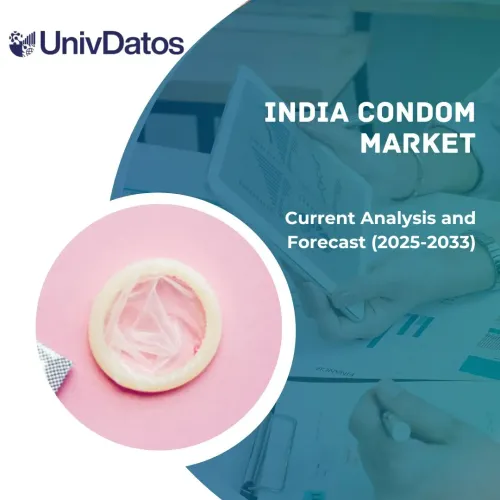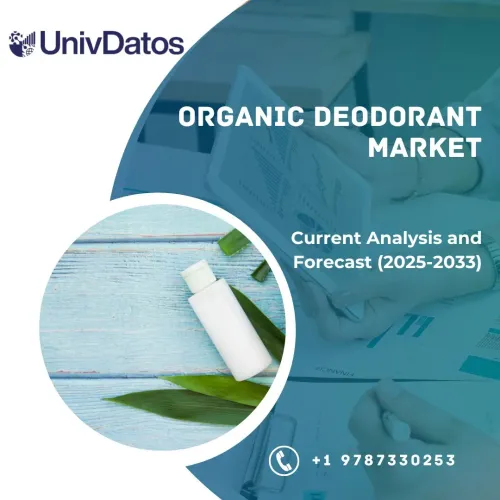- Home
- About Us
- Industry
- Services
- Reading
- Contact Us
Sustainable Personal Care Products Market: Current Analysis and Forecast (2022-2030)
Emphasis on Sustainability Type (Renewable Energy, Regenerative Beauty, Reduced Plastic, and Zero Waste Beauty); Type (Skin Care, Hair Care, Oral Care, and Hygiene Products); and Region/Country
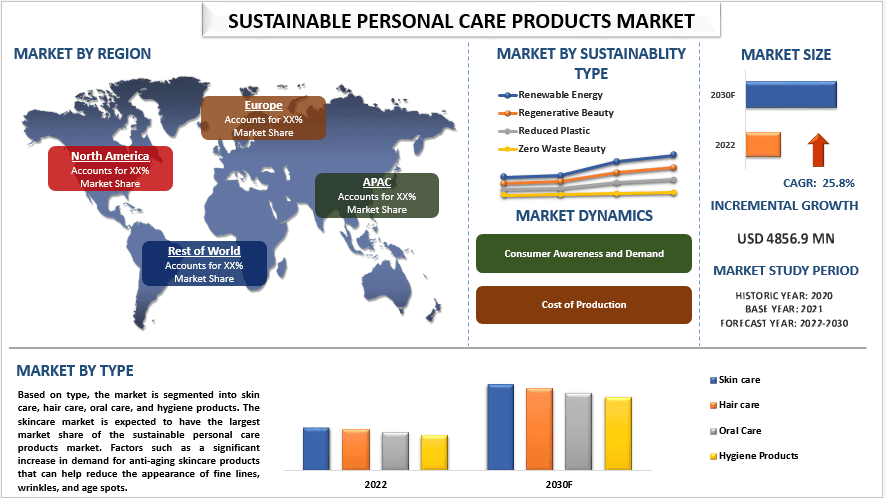
The sustainable personal care products market was valued at USD 4856.9 million in the year 2022 and is expected to grow at a strong CAGR of around 25.8% during the forecast period. Sustainable personal care products are products that are designed to meet the needs of consumers while minimizing the negative impact on the environment and promoting social responsibility. These products are made using natural, non-toxic, and biodegradable ingredients that are renewable and do not harm the environment. They are also manufactured using sustainable practices that reduce waste, conserve energy, and minimize pollution. Sustainable personal care products include a range of products such as skincare, haircare, oral care, and hygiene products, which are produced in a manner that is both environmentally and socially responsible. The goal of sustainable personal care products is to meet the needs of consumers while also promoting sustainability and protecting the environment. Factors driving the growth of the sustainable personal care products market include the increasing popularity of natural and organic products, growing concern over the use of synthetic chemicals in personal care products, and the desire to reduce the environmental impact of personal care products.
Some of the major players operating in the market include Coty Inc; Colgate Palmolive; Estee Lauder Companies; Johnson & Johnson; Kao Corporation; L’Oreal; L’ Occitane Group; P&G; Unilever; Weleda UK Several M&As along with partnerships have been undertaken by these players to facilitate customers with hi-tech and innovative products/technologies.
Insights Presented in the Report
“Amongst sustainability type, the regenerative beauty segment is expected to have the largest market share of the sustainable personal care products market.”
Based on sustainability type, the market is segmented into renewable energy, regenerative beauty, reduced plastic, zero waste beauty and others. The regenerative beauty segment is expected to have the largest market share of the sustainable personal care products market. Consumers are increasingly concerned about the environmental impact of their beauty products. Regenerative beauty emphasizes the use of sustainable and renewable ingredients, as well as eco-friendly packaging and production methods. Furthermore, regenerative beauty emphasizes the use of ingredients that promote the health and well-being of the skin, such as natural plant extracts and antioxidants. This approach also recognizes the link between overall health and beauty, emphasizing the importance of a healthy lifestyle and holistic self-care. These factors are expected to drive the market during the forecast period.
“Amongst type, the wireless smart home technology held the majority share of the market in 2021”
Based on type, the market is segmented into skin care, hair care, oral care, and hygiene products. Among them, the hygiene products category grow at a fastest CAGR during the forecast period. This is mainly due to the sustainable hygiene products involve reducing waste by using products that have minimal packaging, by choosing refillable products, and by using products that have a longer lifespan. Additionally, supporting fair labor practices and reducing carbon emissions by using energy-efficient production methods are important aspects of sustainable hygiene products.
“North America dominated the Sustainable Personal Care Products Market in 2021”
North America dominated the Sustainable Personal Care Products Market in 2021 with more than 44% share of the market due to the increased demand for smart devices due to technological advancements and overall consumer awareness. Considering the rapid growth prospects of the region in every aspect, growth is mainly attributed to favorable conditions of development in terms of recovery of the residential market and better affordability coupled with rising penetration of smart homes in North America over the forecasted period.
Sustainable Personal Care Products Market Report Coverage
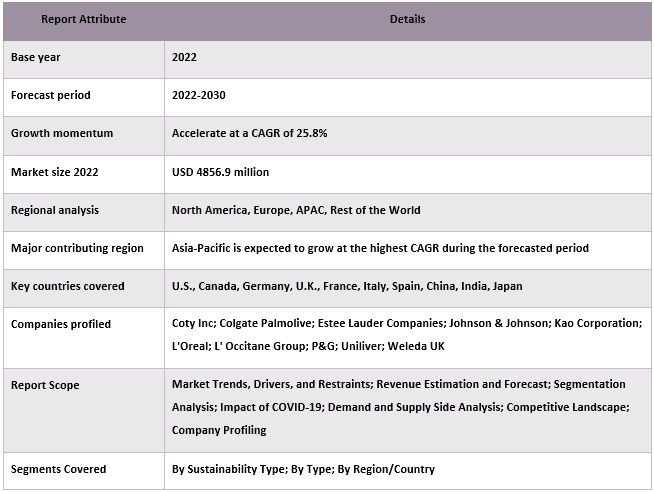
Reasons to buy this report:
- The study includes market sizing and forecasting analysis validated by authenticated key industry experts.
- The report presents a quick review of overall industry performance at one glance.
- The report covers an in-depth analysis of prominent industry peers with a primary focus on key business financials, product portfolios, expansion strategies, and recent developments.
- Detailed examination of drivers, restraints, key trends, and opportunities prevailing in the industry.
- The study comprehensively covers the market across different segments.
- Deep dive regional level analysis of the industry.
Customization Options:
The global Sustainable Personal Care Products Market can further be customized as per the requirement or any other market segment. Besides this, UMI understands that you may have your own business needs, hence feel free to contact us to get a report that completely suits your requirements.
Table of Content
Research Methodology for the Sustainable Personal Care Products Market Analysis (2022-2030)
Analyzing the historical market, estimating the current market, and forecasting the future market of the global Sustainable Personal Care Products Market were the three major steps undertaken to create and analyze the adoption of smart homes in major regions globally. Exhaustive secondary research was conducted to collect the historical market numbers and estimate the current market size. Secondly, to validate these insights, numerous findings and assumptions were taken into consideration. Moreover, exhaustive primary interviews were also conducted, with industry experts across the value chain of the global Sustainable Personal Care Products Market. Post assumption and validation of market numbers through primary interviews, we employed a top-down/bottom-up approach to forecasting the complete market size. Thereafter, market breakdown and data triangulation methods were adopted to estimate and analyze the market size of segments and sub-segments of the industry pertains to. Detailed methodology is explained below:
Analysis of Historical Market Size
Step 1: In-Depth Study of Secondary Sources:
Detail secondary study was conducted to obtain the historical market size of the Sustainable Personal Care Products Market through company internal sources such as annual reports & financial statements, performance presentations, press releases, etc., and external sources including journals, news & articles, government publications, competitor publications, sector reports, third-party database, and other credible publications.
Step 2: Market Segmentation:
After obtaining the historical market size of the Sustainable Personal Care Products Market, we conducted a detailed secondary analysis to gather historical market insights and share for different segments & sub-segments for major regions. Major segments are included in the report as sustainability type and type. Further country-level analyses were conducted to evaluate the overall adoption of testing models in that region.
Step 3: Factor Analysis:
After acquiring the historical market size of different segments and sub-segments, we conducted a detailed factor analysis to estimate the current market size of the Sustainable Personal Care Products Market. Further, we conducted factor analysis using dependent and independent variables such as sustainability type and type of the Sustainable Personal Care Products Market. A thorough analysis was conducted of demand and supply-side scenarios considering top partnerships, mergers and acquisitions, business expansion, and product launches in the Sustainable Personal Care Products Market sector across the globe.
Current Market Size Estimate & Forecast
Current Market Sizing: Based on actionable insights from the above 3 steps, we arrived at the current market size, key players in the global Sustainable Personal Care Products Market, and market shares of the segments. All the required percentage shares split, and market breakdowns were determined using the above-mentioned secondary approach and were verified through primary interviews.
Estimation & Forecasting: For market estimation and forecast, weights were assigned to different factors including drivers & trends, restraints, and opportunities available for the stakeholders. After analyzing these factors, relevant forecasting techniques i.e., the top-down/bottom-up approach were applied to arrive at the market forecast for 2030 for different segments and sub-segments across the major markets globally. The research methodology adopted to estimate the market size encompasses:
- The industry’s market size, in terms of revenue (USD) and the adoption rate of the Sustainable Personal Care Products Market across the major markets domestically
- All percentage shares, splits, and breakdowns of market segments and sub-segments
- Key players in the global Sustainable Personal Care Products Market in terms of products offered. Also, the growth strategies adopted by these players to compete in the fast-growing market
Market Size and Share Validation
Primary Research: In-depth interviews were conducted with the Key Opinion Leaders (KOLs) including Top Level Executives (CXO/VPs, Sales Head, Marketing Head, Operational Head, Regional Head, Country Head, etc.) across major regions. Primary research findings were then summarized, and statistical analysis was performed to prove the stated hypothesis. Inputs from primary research were consolidated with secondary findings, hence turning information into actionable insights.
Split of Primary Participants in Different Regions
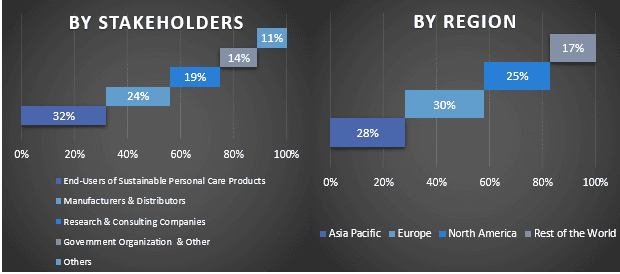
Market Engineering
The data triangulation technique was employed to complete the overall market estimation and to arrive at precise statistical numbers for each segment and sub-segment of the global Sustainable Personal Care Products Market. data was split into several segments & sub-segments post studying various parameters and trends in the areas of the sustainability type and type in the global Sustainable Personal Care Products Market.
The main objective of the Global Sustainable Personal Care Products Market Study
The current & future market trends of the global Sustainable Personal Care Products Market were pinpointed in the study. Investors can gain strategic insights to base their discretion for investments on the qualitative and quantitative analysis performed in the study. Current and future market trends determined the overall attractiveness of the market at a regional level, providing a platform for the industrial participant to exploit the untapped market to benefit from a first-mover advantage. Other quantitative goals of the studies include:
- Analyze the current and forecast market size of the Sustainable Personal Care Products Market in terms of value (USD). Also, analyze the current and forecast market size of different segments and sub-segments
- Segments in the study include areas of the sustainability type and type
- Define and analysis of the regulatory framework for the smart home industry
- Analyze the value chain involved with the presence of various intermediaries, along with analyzing customer and competitor behaviors of the industry
- Analyze the current and forecast market size of the Sustainable Personal Care Products Market for the major region
- Major countries of regions studied in the report include Asia Pacific, Europe, North America, and the Rest of the World
- Company profiles of the Sustainable Personal Care Products Market and the growth strategies adopted by the market players to sustain in the fast-growing market
- Deep dive regional level analysis of the industry
Related Reports
Customers who bought this item also bought





